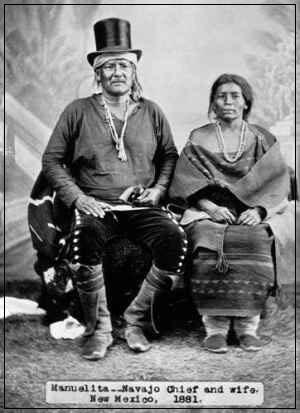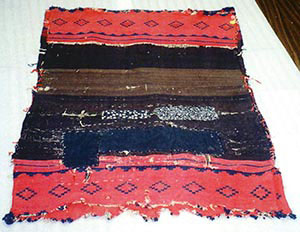 |
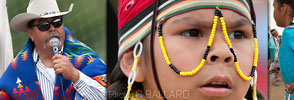 |
 |
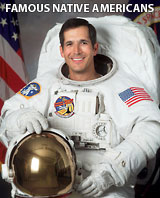
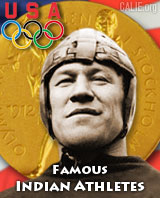
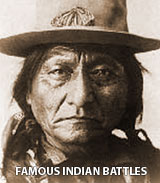
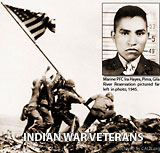
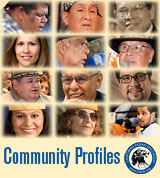
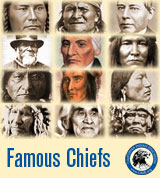
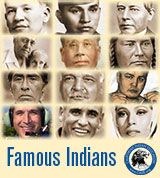
Publishing Corner: Indian Community: Science & Wonder Indian Heros: California Indian Art: CALIE Library: Academic Financial Aid: Tribal Governments: Indian Gaming: |
CHIEF MANUELITOReclaiming the Pride of the Diné Culture
According to Museum Director Manuelito Wheeler, who was named after the great chief and may be a distant relative, an exhibit on Manuelito is long overdue. "We've already gotten a lot of feedback on this exhibit and I think it may turn out to be the best-attended ever," he said Tuesday as his employees were busy putting up the displays. He's easily the Navajo Tribe's most famous leader, and yet no in-depth exhibit on his life has ever been undertaken. Until now. Friday, Aug. 27, the Navajo Nation Museum opened "The Chief Manuelito Exhibit," a look at Manuelito and other early leaders of the Diné. We'll take an in-depth look at the events of his life and the decisions he made that still affect us today," Wheeler said. For instance, he said, the Navajos were among the first tribes in the Western U.S. to embrace education, largely thanks to Manuelito's example of sending his children to boarding school. "He saw that white people have the things that we need, and knew we could only get them through education," Wheeler said. In a sense, every Navajo Ph.D, doctor and lawyer is a legacy of Manuelito. While there were other strong Navajo leaders before and after Manuelito, he may be the most remembered because he was in power during a pivotal time of conflict with the U.S. government. "He resisted (the government) for so long in spite of the adversities he was up against," Wheeler said. "Navajo people admire that about him." While artifacts of the great chief are rare, there is an abundance of oral history concerning him, including accounts from his children. Military correspondence referring to him gives an insight into his relationship with the U.S. government. "How important he was to the Navajo people is evidenced by the fact that the military was under specific orders to capture him," Wheeler explained. "They thought if they could capture Manuelito, the Navajo people would be defeated." Guest - curating the exhibit is Manuelito's great-great-great-grandaughter and biographer, Jennifer Nez Denetdale. Those who read Jennifer Nez Denetdale's book "Reclaiming Navajo History" may remember her description of traveling to the Southwest Museum in Los Angeles to see a dress woven and worn by her great-great-great-grandmother, Chief Manuelito's favorite wife Juanita. Well, the dress is returning the visit.
The dress woven and worn by Chief Manuelito's wife Juanita will be displayed at the Navajo Nation Museum. The dress is part of an exhibit on Chief Manuelito that will open with a public reception on Aug. 27. (2010?) On Tuesday, Aug. 24, a climate-controlled truck bearing the dress and a saddle blanket also woven by Juanita (whose Navajo name was Asdzáá Tl'ógí, "Weaver Woman") will roll into Window Rock where it will be met by Denetdale and Navajo Nation Museum Curator Clarenda Begay. "I'm so, so excited," Begay said. "This is a big deal." Unfortunately, the women won't be able to unpack the textiles until Thursday morning, 22 hours later. Good curation demands the 142-year-old dress and the somewhat newer blanket rest in their specially designed boxes for that long before being opened. A curator from the Autry National Center (formerly the Southwest Museum) will accompany the items to make sure they're unpacked and exhibited correctly. The items will be on loan as part of the museum's planned exhibit on Chief Manuelito, which will open with a public reception at 5 p.m. Friday, Aug. 27. To the untrained eye, it may be hard to see what all the fuss is about. The dress is a tattered piece of woolen fabric, patched with calico in several places. But it's one of the few surviving artifacts of Juanita, a stateswoman in her own right who accompanied her husband on delegations to Washington. "To see something that belonged to her, that she actually wove and wore, is really significant to me and all her descendants," said Denetdale, who is helping Begay with the exhibit. "But this isn't just family history. This is Navajo history. I hope everyone will want to see it." Begay said the dress is a typical biil, or blanket dress, of its time. The design represents clouds, mountains and sky - the balance of Mother Earth and Father Sky so important in the Diné worldview. "It was a form of modesty," Begay explained. "You didn't want to stand out." Looking at all the patches, "it's obvious she loved the dress and wore it a lot," Begay said. Perhaps that was because the year she wove it - 1868 - was the year her husband and other Navajo leaders signed the treaty that freed their people from internment at Fort Sumner, N.M., and let them return home to their beloved land. According to his own account when he donated the dress to the museum, photographer and collector George Wharton James obtained the dress from Juanita in 1874. Earlier, she had refused to sell it to him but later gave it to him as a gift. She is wearing the biil in several photographs James took of her and her family over the years. "Seeing the dress in pictures, and then really seeing it, makes you think about what she would have experienced and the things our people went through," Begay said. |
CALIF INDIAN EDU NETWORK: AHMIUM.org | SCAIR.org | SDICENTER.org | APAPAS.com
—
PROFESSIONAL BLOGGER BLOG MASTER
www.calie.org COPYRIGHT 2008-Present • ALL RIGHTS RESERVED
